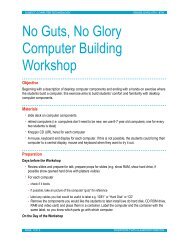Workshop Report - Pervasive Technology Institute - Indiana University
Workshop Report - Pervasive Technology Institute - Indiana University
Workshop Report - Pervasive Technology Institute - Indiana University
Create successful ePaper yourself
Turn your PDF publications into a flip-book with our unique Google optimized e-Paper software.
9. Make sure technology trickles down to the local level. A flexible CI can go big or small.<br />
Make it easy to use for local systems that are not ready to play right now, and when they<br />
are, they will play nice.<br />
10. Pain is an effective motivator. Seminars and tutorials are not sufficient to bring people up<br />
to speed. Engaging users on their turf, in their environment allows them to have their own<br />
struggle-victory story...and share it with you. Those relationships are priceless in building<br />
bridges of any kind.<br />
Section 2: The Software<br />
System Level<br />
A bridging CI should provide a common abstraction layer for users to do their work. This starts at<br />
the systems level, working with vendors make sure that the basic building blocks of accounting,<br />
monitoring, job management, networking, security, and storage are in place before building<br />
up a CI. This is a gap in modern middleware. Lots of effort is spent accounting for everything<br />
happening through the middleware, but little attention is paid to the things happening outside<br />
the middleware. This leads to inconsistencies for users moving between the middleware and the<br />
underlying system.<br />
Building upon the core services mentioned above is an event-driven middleware stack that’s<br />
developed and maintained as part of the national CI. We specifically mention that the middlware<br />
should be event driven so that it allows for both push and pull interaction from users. This is<br />
important because different users have different use cases and it’s is important to enable both<br />
models of access through the middleware.<br />
Security<br />
The underlying security model should be built upon existing standards such as Kerberos and LDAP,<br />
and exposed through widely accepted cross-domain solutions such as OAuth that allow for trust<br />
relationships, single sign-on, and the ability to generate bi-directional audit trails on demand.<br />
Building out custom authentication frameworks is simply not necessary when widely supported<br />
solutions exist. Even if commercial licenses are required for such tools, it will be less expensive than<br />
funding a 5 year effort to custom design something. Adopting an existing, supported solution will<br />
also reduce the integration burden on the CI developers and RP.<br />
Breadth<br />
The CI should also be sufficiently flexible to decouple the concept of an organization from the<br />
underlying resources. As systems and data requirements continue to grow at divergent paces, it will<br />
become increasingly important to see organizations appear who specialize in specific tasks such<br />
as data storage or instrumentation. If a CI cannot represent such single-purpose entities, it will be<br />
difficult to create meaningful partnerships using the CI.<br />
44






